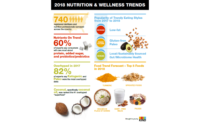The Kerry Health and Nutrition Institute (KHNI) has identified 10 key health and nutrition trends set to shape the food and beverage industry, with women’s health, affordable nutrition, and sugar and salt reduction among some of the top areas for innovation in 2023.
With trends underpinned by a desire for sustainable nutrition, consumers will become more interested in proactively managing their physical and mental health while seeking products that are affordable, healthy and good for the planet. KHNI’s global network scientists and researchers have have put together all you need to know on these trends and what they mean for the food and beverage industry.
Commenting on the report, Nathan Pratt, senior nutrition scientist at Kerry, said: “Sustainability continues to be the leading driver in food and beverage innovation, as consumers become increasingly focused on health and affordability in their nutritional spend. The Kerry Health and Nutrition Institute’s research finds 2023 will see long-standing trends of health and sustainability take more personalised approach to specific consumer groups and need-states. Nutritional innovation is increasingly enabling consumers to proactively manage their physical and mental health including through functional beverages; sex-specific nutrition; and probiotics for more than digestive health.
“We are also seeing consumers placing increased importance on the nutritional density of their foods, as they seek affordable yet healthy alternatives in today’s macroenvironment. The industry must consider all of these trends in the context of feeding a growing global population—a task to which food science and technology will be critically important in the coming year and beyond.”
Leveraging developments in research, technology and product development, KHNI’s experts in science and research have highlighted the following top 10 trends for 2023:
- Functionality flourishing
Functional beverages are leading an industry-wide boom in products aimed to help consumers proactively manage their health. In 2023, we will see a focus on short-term need states of beauty; immune support; digestive health; energy; and weight management.
- Women’s health
Women’s health issues are being increasingly addressed via nutrition with broadening clinical research, delivering innovative supplement launches to support women’s digestive, heart, cognitive, bone, joint and immune health as well as supporting female specific need states such as fertility, breastfeeding and menopause. Although women are at higher risk of nutrient deficiencies than men at certain stages—leading to chronic diseases such as cardiovascular disease, strokes, and cancer—much of the research on these diseases to date has been conducted on men.
- Advanced activity
Joint health and cardiovascular health are not just for healthy ageing anymore—expect to see more products with these benefits targeting all active age groups. Gym-goers are looking to enhance the function of their joints, heart, and vascular system to allow more mobility, more effective workouts, and reduce risk of injury.
- Cognitive health
An increased focus on mental wellbeing post-COVID and growing science on the role of ingredients such as adaptogens and nootropics in brain health is seeing cognitive health carve a strong foothold in the food and beverage space.
- High stakes for sugar and salt
Changes in nutrition and labelling legislation are becoming more widespread, and consumers are becoming more health conscience. Front-of-pack signposting is increasing to make healthier choices more simple but is also driving the increasing need for innovative technology to help manufacturers create healthier, more sustainable products, that deliver on taste and experience.
- Affordable nutrition
Inflation is at 40-year high, and affordable sustainable nutrition has never been more critical. Food innovation is not only focused on premium novel ingredients, but also on how we can make the food system more economically sustainable by maximizing the nutritional density and affordability of foods.
- Protein production’s future
It will be nearly impossible to feed the planet’s population growth using our current systems of food production – with an expected global popular of 10 billion by 2050. Food science and technology will be critically important to innovate alternative means of producing the protein required to feed the planet.
- Microbiome—beyond digestive health
Microbes extend far beyond the gut or digestive tract, and microbiologists are identifying more and more bacteria with interesting properties. The microbiome has been linked to a multitude of health benefits beyond digestive health including reproductive and cardiometabolic health, alongside immunity. As advances in molecular research continue, it is of tremendous importance that associated probiotic products deliver the benefits they are claimed to.
- Hydration optimized
Hydration is moving beyond plain water, as consumers look for more exciting options such as sparkling water or electrolyte powers. There is also a move away from sweetness in hydration, with sparkling waters and low-sweetness options are being chosen more commonly by consumers looking to hydrate and manage weight.
- Plant-based to plant-forward
Consumers are increasingly looking beyond meat mimicry to plant-forward products as they challenge the heavily processed nature of plant proteins. Plant-forward innovations that offer servings of fruits, vegetables, or whole-grains can help bridge gaps in our day-to-day diets while differentiating themselves in the plant-based market.
Access the full KHNI Health and Nutrition Trends research here.





